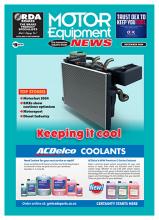By John Oxley
Fake body parts are rife in New Zealand – so much so that “they have become part of doing business,” according to John Manley, MD of Nissan NZ, and president of the Motor Industry Association.
After reading about faulty Commodore replacement car bonnets encountered by a number of Holden owners in Australia, Motor Equipment News contacted local importers, including Holden New Zealand, for their take on the problem.
The issue had arisen in Australia after that country’s automotive industry body, the Federal Chamber of Automotive Industries (FCAI), warned that some imported Holden Commodore bonnets were not durable enough for safe operation.
The chamber announced it had also struck a co-operative agreement with the Department of Immigration and Border Protection in a bid to stamp out the importation of counterfeit parts, and last year the department intercepted and seized 190,000 imported fake parts.
The “fake” Holden Commodore bonnets were tested by Holden engineering staff, as well as Australia’s Centre for Automotive Safety Research (CASR).
The results:
- The fake bonnet increased the chance of traumatic brain injury for pedestrians as the steel was thicker than the “genuine” item and didn’t deform as it was designed to.
- The metal used to make the strike wire – the U-shaped wire on the bonnet which engages with the latch in front of the radiator – was too soft, and would lead to the wire breaking. The wire in the fakes was also poorly mounted into the bonnet and would eventually pull free of its mounts. This could result in the bonnet flying open at speed, with catastrophic results.
- The standard bonnet struts were “overwhelmed” by the heavier steel bonnet, and could fall onto the heads of people working in the engine bay, or even just performing routine maintenance..
“This has been going on in New Zealand for years,” said John Manley. “Usually pirate imported parts are nowhere near OEM factory specification. It’s something most of the Japanese franchises in particular have learned to live with.
“Anything coming out of Thailand or Japan, there’s a plethora of parts being offers on Trade Me and whatever that’s nowhere near specification.
“You only need to talk to some panel beaters, and they’ll tell you it often takes so much time to try to make the pirate parts fit that they’d have been better off buying genuine parts in the first place.”
John recounted a personal experience involving his son, who needed a rear bumper for his Nissan Navara. He bought a cheap part, but says John, “it was so flimsy you could bend it into a corkscrew with your bare hands”.
The solution?
“Buy genuine parts,” says John. “They are properly designed, made to fit, and made from the correct materials. If you buy ‘cheap’, you get what you pay for!”.
That said, there seem to be no problems with fake parts reported to Holden New Zealand.
“We haven’t been advised of any instances in NZ, but in the meantime, we would strongly recommend people to purchase genuine Holden parts via the authorised network of dealers and service centres,” said Ed Finn, general manager – corporate affairs.
However, unsafe parts have been an issue at Suzuki New Zealand.
Said Paul Cornforth, general manager parts and accessories: “Suzuki New Zealand has issued advice to the dealer network in the past on several occasions, to be passed on to the trade, and has been in the motor repair media, particularly the panel repair sector, reinforcing that not only aftermarket, but also genuine parts parallel imported from other markets, are not necessarily manufactured to the same vehicle compliance codes as those made/required for our market spec.
“They therefore cannot be legally fitted, and are a safety concern.”
Mitsubishi’s Daniel Cook, head of sales and marketing strategy, noted: “I’ve got no doubt that non-genuine parts for our vehicles are being imported and sold. Unlike the Holden situation though, I don’t have confirmed and clear examples of those parts performing in a dangerous manner.
“Obviously a non-genuine part is not developed to the same tolerances and standards as a genuine one, so it stands to reason they will not perform as well.
“One measure we take is through our branded insurance; only genuine parts will be used in a repair on a Mitsubishi vehicle. This gives our insurance customers peace of mind that only the best quality parts, designed for their vehicles, will be fitted.”
Hyundai New Zealand’s sponsorship and events manager Daniel Page said the issue was not applicable to Hyundai in this country at this stage. “We’re not aware of any counterfeit parts that would apply here”, he said.
Paul Bowness, parts & accessories sales manager at Toyota New Zealand commented: “We haven’t heard of any similar incidents for Toyota either here or Australia. As such we don’t want to issue a warning to customers.”
And Maria Tsao, marketing services manager of Mazda NZ, said Mazda’s parts manager cannot recollect any instances of issues with counterfeit products in New Zealand. “Mazda parts are competitively priced in NZ, and the pricing model is quite different to NZ,” she said.



